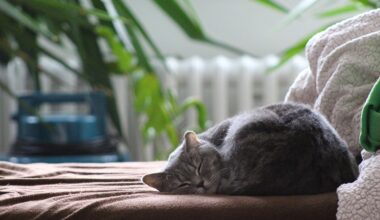The Benefits of Catnip for Cats
Catnip, scientifically known as Nepeta cataria, has been enjoyed by felines for centuries. This herb is part of the mint family and contains a compound called nepetalactone, which induces a playful and euphoric reaction in many cats. When they encounter catnip, they may engage in behaviors such as rolling, purring, and increased playfulness. As such, this natural herb is popular among cat owners who want to enrich their pets’ lives. Not all cats respond to catnip, but approximately 50% to 70% exhibit some reaction to it, and this reaction is hereditary. Young kittens aged below six months usually do not respond to catnip, making the age of the feline a critical factor. Offering catnip safely involves using it in moderation and observing how your cat reacts to it. This means ensuring it is used as a treat rather than an excessive toy, to maintain its effectiveness. Catnip also comes in various forms, including dried leaves, sprays, and filled toys, making it accessible for every cat’s preference.
Introducing catnip to your feline friend can offer various health benefits. First, catnip can help to reduce stress and anxiety in cats, providing a calming effect. If you notice your cat acting timid or stressed in unfamiliar situations, a little catnip can alleviate that tension. Secondly, catnip promotes physical activity, which is essential for maintaining a healthy weight and mitigating obesity risks. When cats play and engage in activities stimulated by catnip, they exercise their muscles, improving overall health. Additionally, relaxation after a playful session helps lower stress hormones in cats, promoting mental well-being. Catnip can also encourage older or less active cats to engage with their surroundings, making it ideal for cats that are usually sedentary. Kittens tend to respond positively to catnip when they experience playtime, leading to socialization and learning behaviors necessary for their development. Incorporating catnip into your cat’s routine may produce positive changes. Remember to monitor how often and in what quantity you present it to your cat, ensuring it remains a special treat.
Understanding Catnip’s Effects
The effects of catnip vary widely between felines, with the response duration ranging from 10 to 15 minutes. After experiencing the excitement, your cat will typically lose interest in the herb for a while. After a period of approximately one hour, they may become receptive to catnip again. It’s also important to note that some cats may show different levels of stimulation, ranging from aggressive play to mellower behaviors. Observing your cat’s reactions can help you understand its preferences and tolerances better. Aside from the immediate behavioral effects, there has also been some research to suggest that catnip may have herbal properties that are beneficial for felines. Some studies propose that catnip may even repel certain pests, providing another layer of protection for your pet. While many benefits are provided, it’s wise to consult with a veterinarian before introducing catnip into your cat’s diet, particularly if there are any underlying health issues. Overall, providing stimulating experiences for your cat can significantly enhance their quality of life and build positive associations.
In addition to its playful effects, catnip can assist with dental health. Chewing on catnip toys or treats can help remove plaque buildup and promote healthier gums. This can be a relatively passive method of supporting your cat’s dental hygiene while also encouraging fun playtime activities. Additionally, catnip may serve as an effective training tool when introducing new toys or litter boxes. Sprinkling a little catnip attracts your cat to these new items, making them more tempting and engaging. Transitioning to different types of food can also be less stressful when mixing catnip with the new food, enhancing acceptability. Different cats possess unique personalities, so encouraging exploration can be beneficial in helping your cat adapt to snuggling more. Offering catnip in socially constructive ways can provide comfort. Finally, offering rewards in the form of catnip can render training sessions productive, achieving desired behaviors through positive reinforcement. Establishing these habits enhances the bond between feline and owner while keeping both the cat’s mental and physical well-being a priority.
How to Use Catnip
Using catnip involves ensuring you are sourcing high-quality products free of chemicals, as these could negatively affect your pet’s health. Always look for organically grown catnip to maximize benefits and minimize risks. When introducing catnip to your home, consider trying various forms, including dried leaves, catnip-filled toys, sprays, or even growing your own catnip plant. Experimentation is key; you may discover that your feline shows a preference for certain forms or concentrations. Applying freshly crushed catnip leaves to scratching posts or putting a sprinkle in their food may enhance interest. Observe how your feline reacts, guiding how and when you incorporate it into their routine. The frequency should be moderate to prevent desensitization. While providing your cat with enriching activities, it’s essential to note any adverse reactions. If your cat demonstrates aggression or extreme overstimulation, consider reducing its frequency. Overall, responsibly using this natural herb can play an essential role in cat care. The potential benefits can significantly improve your pet’s delight and engagement while providing unique experiences.
Moreover, ensuring that your cat has access to a safe place where they can relax after enjoying catnip is equally essential. This means providing a cozy blanket or place like a favorite bed where they can unwind. Offering this space reinforces positive behaviors while keeping a soothing environment. Additionally, watching how your cat interacts with various toys can illuminate what types captivate their attention the most. Toy selection should cover different functions, including chasing, pouncing, and chewing, to keep your cat stimulated. You can also alternate what they have access to, which can prevent boredom. Incorporating puzzle toys filled with catnip can enhance challenge and rewards simultaneously. This may lead to more prolonged engagement and exercise for your feline friend. As new types of catnip products flood the market, you may also find combinations with other appealing flavors like valerian root or silvervine. Ultimately, paying attention to those commercial products ensures you select what brings your pet joy. This ongoing pursuit of enrichment contributes to elevating a cat’s living experience while strengthening the human-animal bond.
Conclusion
In conclusion, catnip provides numerous benefits that can significantly enhance your feline friend’s quality of life. From stress relief and increased physical activity to promoting dental health and improving trainability, catnip is a versatile herb with various uses. This unique plant is a natural remedy offering enjoyment, play, and relaxation to cats when appropriately introduced. Owners witnessing the delightful excitement catnip sparks in their pets is heartwarming and confirms its effectiveness. Each cat is unique, with some showing increased enthusiasm while others might be more subdued. So understanding individual responses is crucial for successfully incorporating catnip into your cat’s life. When used sensibly, this herb delivers endless enjoyment and enriches daily activities. Moreover, cat owners can engage in finding exciting catnip products. Investing in durable toys or even growing your own catnip plant adds an interactive dimension to the relationship. As with any pet enrichment activity, monitoring interactions should be prioritized, and regular assessment can enhance experiences. Overall, when given a place in your home, catnip proves to be a meaningful addition to support your cat’s mental and physical wellness.
Lastly, always remember to consult with your veterinarian about the appropriate amounts and frequency of catnip usage. Professional guidance will help you understand how to incorporate it into your cat’s routine. Monitoring your cat after serving catnip is equally critical to ensure they have positive experiences. Taking the initiative to enhance your cat’s environment will significantly improve their happiness while fostering engagement. Regular play brings excitement and forges a stronger bond between you and your cat. In doing so, you may lead them toward a healthier, happier lifestyle. Enhancing their living area with diverse toys and experiences further cements this bond. Offering cats a stimulating environment positively impacts mental well-being, leads to healthier behaviors, and reduces stress levels. Involving interactive toys and catnip creates naturally playful surroundings that every cat will enjoy. Catnip’s presence in treatment plans can benefit more than just mental well-being but also physical aspects, making it a must-have in promoting feline wellness. Repeatedly providing these interactions will not just enhance their lives but also cultivate unique experiences to cherish together.


